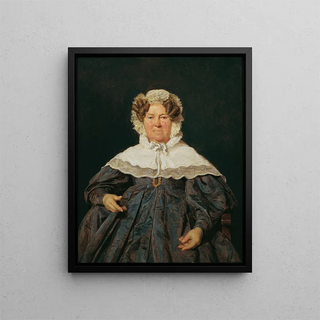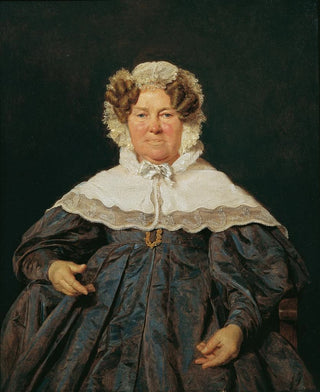Art print | Joséphine Schaumburg née Stahel - Ferdinand Georg Waldmüller


View from behind

Frame (optional)
Art print of Joséphine Schaumburg née Stahel - Ferdinand Georg Waldmüller – Engaging introduction
In the rich and diverse panorama of art history, certain works stand out for their ability to capture the very essence of humanity. The art print of Joséphine Schaumburg née Stahel - Ferdinand Georg Waldmüller is a perfect example. This painting, depicting a woman with undeniable charm, is much more than a simple image: it is a testament to the Romantic era, a time when emotion and sensitivity took precedence over academic rigor. The piece invites us to immerse ourselves in a universe where every detail, every nuance, tells a story — that of a woman, but also that of a society in full transformation.
Style and uniqueness of the work
Ferdinand Georg Waldmüller’s style is both delicate and powerful. In this piece, he manages to blend realism and poetry, offering a portrait that transcends mere visual representation. The carefully orchestrated light highlights the features of Joséphine Schaumburg, while creating an intimate atmosphere. Every element of the painting, from the choice of colors to the model’s posture, is designed to evoke a deep emotion. Waldmüller, a true master, uses oil painting techniques to bring his subject to life, making the canvas almost alive. This attention to detail and sensitive approach make this work a centerpiece that attracts and captivates the viewer.
The artist and his influence
Ferdinand Georg Waldmüller, an emblematic figure of the 19th century, is often regarded as one of the pioneers of realism in painting. His innovative approach marked a break with the conventions of his time, favoring a more accessible style closer to human concerns. Influenced by the social and political upheavals of his era, Waldmüller was able to translate these changes through his works. His talent lies not only in his ability to faithfully depict his subjects but also in infusing a psychological dimension into his portraits. This way of painting has inspired many artists, paving the way for new explorations in portraiture and realism. Rediscovering works like that of Joséphine Schaumburg reveals the lasting impact of Waldmüller.

Matte finish

View from behind

Frame (optional)
Art print of Joséphine Schaumburg née Stahel - Ferdinand Georg Waldmüller – Engaging introduction
In the rich and diverse panorama of art history, certain works stand out for their ability to capture the very essence of humanity. The art print of Joséphine Schaumburg née Stahel - Ferdinand Georg Waldmüller is a perfect example. This painting, depicting a woman with undeniable charm, is much more than a simple image: it is a testament to the Romantic era, a time when emotion and sensitivity took precedence over academic rigor. The piece invites us to immerse ourselves in a universe where every detail, every nuance, tells a story — that of a woman, but also that of a society in full transformation.
Style and uniqueness of the work
Ferdinand Georg Waldmüller’s style is both delicate and powerful. In this piece, he manages to blend realism and poetry, offering a portrait that transcends mere visual representation. The carefully orchestrated light highlights the features of Joséphine Schaumburg, while creating an intimate atmosphere. Every element of the painting, from the choice of colors to the model’s posture, is designed to evoke a deep emotion. Waldmüller, a true master, uses oil painting techniques to bring his subject to life, making the canvas almost alive. This attention to detail and sensitive approach make this work a centerpiece that attracts and captivates the viewer.
The artist and his influence
Ferdinand Georg Waldmüller, an emblematic figure of the 19th century, is often regarded as one of the pioneers of realism in painting. His innovative approach marked a break with the conventions of his time, favoring a more accessible style closer to human concerns. Influenced by the social and political upheavals of his era, Waldmüller was able to translate these changes through his works. His talent lies not only in his ability to faithfully depict his subjects but also in infusing a psychological dimension into his portraits. This way of painting has inspired many artists, paving the way for new explorations in portraiture and realism. Rediscovering works like that of Joséphine Schaumburg reveals the lasting impact of Waldmüller.






